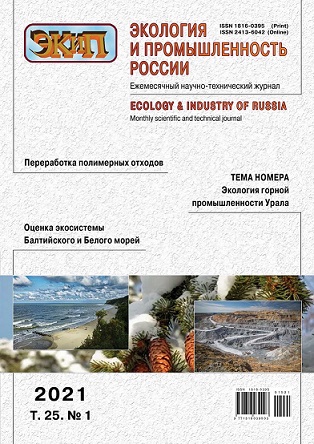Журналу «Экология и промышленность России» присвоена категория К1 в соответствии с методикой, разработанной ВАК Минобрнауки (письмо от 06.12.2022г. № 02-1198) на основе анализа Перечня рецензируемых научных изданий.

Scientific-and-practical reviewed journal "Ekologia i promyshlennost Rossii" («Ecology and Industry of Russia»)
The Journal has been published since 1996.
The Journal is in full color. Its periodicity is 12 numbers annually. Each number capacity amounts to four printer's sheets (64 page ribbons).
The journal «Ecology and Industry of Russia» is distributed through the subscription agency «Ural-Press» and other alternative subscription agencies in printed and electronic form. You can also subscribe to the journal through the publisher. The journal's circulation is about 1000 copies.
The Editorial Council of the Journal and the Editorial Board include four academicians of theRussian Academy of Sciences, three corresponding members of the Russian Academy of Sciences, 23 doctors of sciences representing leading scientific centers of Moscow, St.-Petersburg, Samara, Perm, Novosibirsk. Three specialists from Holland, Finland,I taly enter the Editorial Staff.
The Journal purpose is to promote the acquaintance of world public and specialists interested in environment protection problems with advanced achievements of the science and engineering practice on provision of stable (self-supporting) evolution within the limits of the UN accepted recommendations (RIO 92 and RIO+20). The range of papers includes basic researches and engineering decisions, analytical and methodical works, surveys on the Journal topics. In substance, the "Ekologia i promyshlennost Rossii" («Ecology and Industry of Russia») Journal is an informational scientific-technical book of reference about the newest developments of the Russian and foreign scientists and the companies realized in Russia, the CIS countries and Baltic states.
All the papers and surveys published in the Journal pass obligatory reviewing mainly by members of the Editorial Staff or known scientists and specialists on specific subjects. Works of foreign specialists are also published in the journal. Young scientists are authors of approximately 40 % of publications.
As per the decision of the Highest Certifying Commission of the Ministry for Education and Science of Russia, the "Ekologia i promyshlennost Rossii" («Ecology and Industry of Russia») Journal enters regularly the «List of Periodic Scientific and Scientific-Technical Publications issued in theRussian Federation».
As of December, 2022, according to the analysis of the "Russian Index of Scientific Citation», the "Ekologia i promyshlennost Rossii" («Ecology and Industry in Russia») Journal heads the list in the SCIENCE INDEX rating for 2021 in the subject of "Protection of the Environment. Human Ecology", the two-year impact-factor, as of 2021, with allowance for citation from all sources was 1.761, self-citation factor of 16 (detailed information in the site: http://elibrary.ru/title_profile.asp? id=7351).
The journal is included in the database of Russian Science Citation Index (RSCI), disposed on the platform Web of Science and the database GeoRef.
Founder
- Siberian Branch of the Russian Academy of Sciences
- Federal Research Center Boreskov Institute of Catalysis
- National University of Science and Technology «MISiS»
- Limited Liability Company «KALVIS» (Publisher)
Postal address of Editorial Office
119049, Moscow, PO 28. ZAO «KALVIS» for "Ekologia i promyshlennost Rossii" («Ecology and Industry of Russia») Journal
Main Editorial contact
+7(963) 664-77-65
e-mail: ecip1996@yandex.ru
+7(495) 913-80-94
e-mail: info@kalvis.ru
Editor-in-chief
Dr. Sci. (Eng.), Prof. A.S. Noskov
e-mail: noskov@catalysis.ru
Executive Secretary
Pogodkina Svetlana Sergeevna
e-mail: pogodkina.ecip@catalysis.ru
Deputy Editor for Social and Legal Problems of Ecology
Dr. Sci. (Eng.), Prof. V.D. Kalner
Deputy Editor-in-Chief
Salnikova Natalia Gennadievna
e-mail: ecip1996@yandex.ru

































